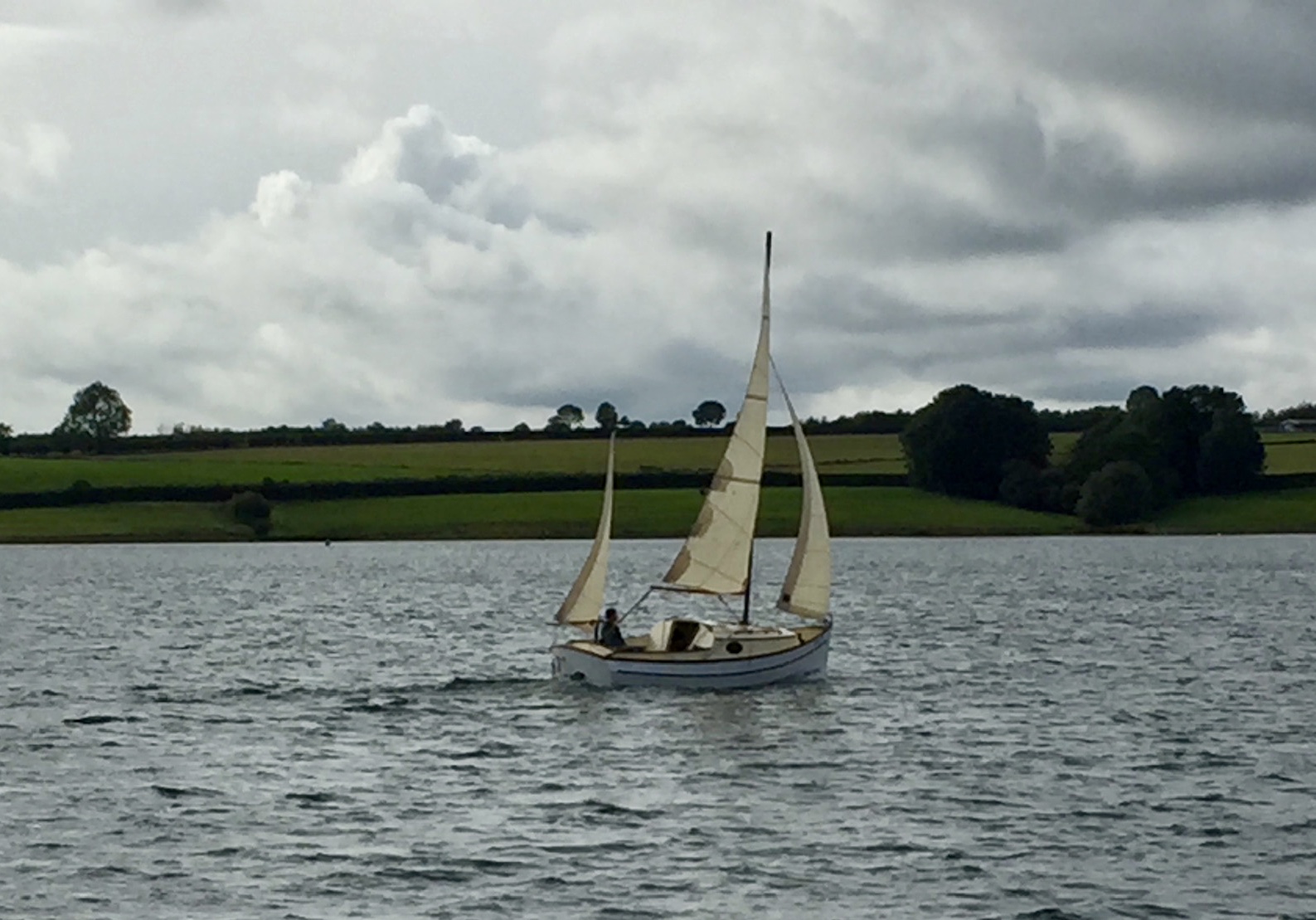 |
| Daisy III now sitting on its modified trailer - new axle with braked wheels. The widest point of the hull is quite close to the new mudguards, but this should hopefully not present a problem. |
It has been a strange summer in an even stranger year. Following the last cruise in August, it became apparent that there were serious issues with the boat trailer, principally due to the overall towing load being too heavy for the un-braked trailer.
The original BC20 was sold as being 451kg when 'empty', sitting on an un-braked trailer of 200kg, thus allowing just under 100kg for additional loads prior to reaching the towing limit of 750kg for such a trailer. This seemed a flawed approach for all sorts of reasons:
- Despite polite enquiries, it was not possible to achieve a straight answer to the important question of what precisely constituted an 'empty' boat. Does it mean the finished hull alone, or does it include mast, spars, sails, cabin bunk cushions, rigging? These items would easily make up the 100kg difference. Moreover, this particular boat is a modified version, currently with a Lavac sea loo installed on the starboard side. How much additional weight is this?
- Anyone who owns a boat will appreciate the necessity of carrying all sorts of additional kit and clobber. Must this be carried separately, loaded onto the boat before each launch, and correspondingly removed at the end of a sail? For one, an outboard motor adds a considerable weight and is the sort of item so awkward to load that the single handed sailor would be excused for wanting to fit it just once, at the start of the boating year, and then leave in place throughout the season. Then, one must consider anchor, chain, second anchor, ropes, paddle, boat hook, electronics, safety gear, fenders, tools, charts. And that's before the day-to-day essentials such as cooking/eating essentials, ingredients, water, clothing, boots, wet weather clothing etc.
- This is a cabined boat which is all the more reason why one would want to fit out the cabin with all sorts of additional equipment.
- Even if it were possible to keep the weight of the boat below the 750kg limit, it is an undeniable fact that the overall weight will at least be pushing up against that limit. Travelling, safe in the knowledge that the towing weight was well below any such limits, is much the preferable option.
Having done some summer arithmetic (illustrated below), using A-level mechanics 'moments of forces' calculations alongside the somewhat crude use of a set of bathroom scales, the conclusion was that, even with most kit removed, but spars, sails, cabin cushions, ropes and fenders included, the weight of the boat and trailer was at least right on the towing limit and, quite possibly well over. Summer anecdotes from other boat owners being pulled over by the police, and then directed to the nearest weighbridge were a considerable cause for concern. Then, it was the case that much of August was unseasonably windy (conditions this skipper doesn't particularly enjoy) with the brief windows of more settled weather coinciding with other commitments.
Hence, it seemed to be the right time to take drastic action, in the form of having the trailer modified to incorporate brakes. Amongst other things, this involves a new axle with larger wheels, raising the height of the trailer frame (see further modification below). There is nothing innovative about this action; a number of other BC20 owners have previously done the same, either swapping their trailer for a braked version, or having the existing trailer modified to a braked version. In so doing, the upper towing limit becomes much more dependent on the type of vehicle rather than the trailer. Currently, this is a Skoda Superb estate 4x4, with a braked towing limit of two tonnes and, whilst there is no intention of pushing anywhere near this limit, the boat can now be loaded with the kit needed and this can remain aboard throughout the season.
 |
| New hitch and jockey wheel |
CLH trailers, who built the original and who had already carried out similar conversions, were engaged to do the work. This was not without its difficulties due to the various covid lockdowns, and delays in them taking delivery of the requisite parts. To cut a long story short, a hastily arranged swap of the completed trailer at the Welsh border the day before the second lockdown commenced in England has ensured Daisy III is now back at home and awaiting a period of relatively dry conditions prior to putting on the winter covers.
Whilst doing this work, it was timely to carry out a few other modifications. For one, the raised height of the trailer will cause further bother in trying to winch the boat over the rear swinging cradle on launch and recovery, so a couple of rollers have been installed at the lowest central part of this. This is yet to be tested, and it will at least be spring in 2021 before this happens. Hopefully, the process will be similar to this launch and recovery video from Swallowyachts.
 |
| View from the rear, also showing the first of two new, wider central keel rollers |
 |
| It remains to be seen as to how the bow, with winch strap, will roll over these. Fingers crossed for Spring 2021... |
Two of the keel rollers further forward have also been replaced with wider rollers which hopefully are better suited to the relatively wide keelband for this boat.






No comments:
Post a Comment